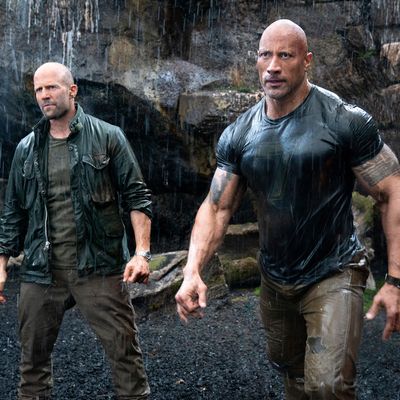
Hobbs & Shaw — or, excuse me, Fast & Furious Presents: Hobbs & Shaw — may look like a desperate money grab, an attempt to deliver a Fast & Furious movie without having to negotiate all those extravagant egos and salaries. But it turns out that whittling the series’ rapidly bulging dramatis personae down to two guys who hate each other can be strangely liberating. The Rock’s gargantuan lawman Luke Hobbs and Jason Statham’s smug former rogue agent Deckard Shaw make nice foils for each other, and the film works best when it takes advantage of the contrapuntal approach of its premise. Early on, we see, in split screen, the duo going about their respective days in Los Angeles and London: Hobbs drives an SUV, Shaw drives a sports car; Hobbs works out, Shaw has an espresso; Hobbs saunters into a scuzzy bar, announces that he’s “what you’d call an ice-cold can of whoop-ass,” and then kicks the shit out of the guys inside via trays to the face and tattoo-gun impalements; Shaw walks into a fancy nightclub, announces that he’s “what you might call a Champagne problem,” and then kicks the shit out of the guys inside using an unopened Champagne bottle. It’s a simple idea, but it’s all executed with precise timing and visual wit.
That’s, like, maybe the first 15 minutes. The exact circumstances under which these two have been brought together are about as basic as these things get. A space-age super-virus that instantly melts people’s insides has been stolen by Shaw’s sister Hattie (Vanessa Kirby), and our heroes need to find it before the bad guys, led by an enhanced super-soldier named Brixton (Idris Elba). Brixton once fought with Shaw in some long-ago war and was presumed dead, but he has now been cyberwhatchamacallited with all sorts of gadgetry and can stop bullets with his hands, throw trucks around, and foresee his opponents’ blows, and he appears to have mind-melded with his motorcycle.
It turns out that Hattie stole the virus specifically to prevent its use by Brixton’s creators and employers, a sinister tech company called Etheon that believes in saving humanity by “enhancing” it. Etheon is run by a disembodied voice that is either an artificial intelligence of some kind or simply the robotically modified vocal inflections of an actual character whom we will presumably meet in the post-credits sequence of some future Fast & Furious movie. Who the hell knows? Who the hell cares? Rarely has a plot mattered less. What works here is the chemistry of the leads, and the ways in which the film plays them not against each other but off each other. When the duo attempt to infiltrate the bad guys’ lair, we see Hobbs, the slow-moving behemoth, pummel one even bigger, even slower dude, while the diminutive Shaw, twirling and buzzing with cyclonic energy, busily handles a whole corridor’s worth of relentless henchmen. So many buddy movies are built solely on banter; this one takes full advantage of the characters’ respective styles and the actors’ competing energies.
That said, the banter isn’t too bad either. The put-downs are surprisingly sharp, even though they do lean a little too hard on not so lightly veiled dick-size jokes. (At one point Shaw forces Hobbs to assume the identity of a man named Mike Oxmaul, getit getit getit? Don’t worry, the film makes sure you do.) It all works because both actors’ careers originated in pastiche. The Rock came from the flamboyantly Über-macho world of pro wrestling, and Statham cut his teeth in Guy Ritchie action comedies and self-aware, hyperviolent schlock. These guys can deliver lines with conviction while simultaneously winking at us. They tread that fine line between being in on the joke and pretending they’re not in on the joke, while somehow making it clear that they’re in on the joke. (Which is also why extended cameos from Kevin Hart as an overambitious air marshal and Ryan Reynolds as an overfriendly CIA agent don’t quite work here — they’re too over-the-top comedic.) Vanessa Kirby, meanwhile, is wonderfully regal, even when she’s choking a guy with her thighs or headbutting the Rock with a motorcycle helmet. Not once did I buy her as Statham’s sister. But not once did I care that I did not.
The director, David Leitch, is a former stunt coordinator who, along with Chad Stahelski, helmed the first John Wick and then moved on to franchise fare with Deadpool 2. His proficiency with real-world action gives a lot of the set pieces in Hobbs & Shaw a pleasant solidity that the Fast & Furious series has steadily moved away from — ironic, perhaps, since this entry also introduces such goofy sci-fi elements as super-soldiers, A.I. overlords, and programmable megaviruses.
But not all action set pieces are created equal: The physical combat is tightly choreographed and elegant, and a climactic, Seven Samurai–inspired melee in Samoa is both rousing and inventive, with an eye-popping bit where a whole series of ramshackle trucks chain themselves together mid-chase to bring down a helicopter. But there are parts that seem lifeless and obligatory. A car-and-motorcycle pursuit through London has some cute stunts but feels like a retread of scenes that the Mission: Impossible series has already topped. And a big, confusing, explosive face-off at Etheon headquarters, with collapsing buildings and jeeps and cycles and planes and trucks and people flying from vehicle to vehicle, feels like something cooked up specifically to remind us that this is a Fast & Furious movie. And while that series has certainly had its moments, it has also become more soap-opera-like with each new entry. At its best, Hobbs & Shaw offers a refreshing antidote to the bloat. I’d rather watch another one of these than sit through one more Vin Diesel speech about family.


